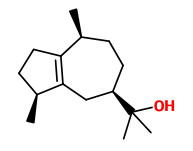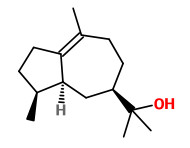Dies ist eine alte Version des Dokuments!
Bulnesia sarmientoi Lorentz ex Griseb. - Zygophyllaceae
Paraguay lignum vitae, (Paragay) guaiacwood, verawood, palo santo (span.), Paraguay Guajakholz, Paraguay Pockholz
Large tree, endemic to the Gran Chaco region of central South America (Paraguy to Bolivia).
Guaiac is also the name of the trees and the resins of Guaiacum officinale and Guaiacum sanctum, both also called 'lignum vitae'.
The volatile oil of B.sarmientoi (Guaiac wood oil or short Guaiac oil) is obtained by steam distillation of a mixture of wood and sawdust. The 'oil' (a yellow to greenish semi-solid substance that melts at ca. 40–50◦C) has a soft rose-like odour, and has thus been used as an adulterant for rose oil. Major components are guaiol (20%, sweet woody balsamic) and bulnesol (35%, dry balsamic woody); minor ones (−)-hanamyol (2.5%), α-eudesmol (3.6%), 7-epi-α-eudesmol (3.2%), γ-eudesmol (2.5%), α-bulnesene (1.1%), guaioxide (0.5%), elemol (0.5%), eudesm-5-en-11-ol (0.7%), β-guaiene (0.1%, sweet woody).
[Advances in the identification and agrochemical importance of sesquiterpenoids from Bulnesia sarmientoi essential oil., Rodilla, J.M., Silva, L.A., Martinez, N., Lorenzo, D., Davyt, D., Castillo, L., Dellacassa, E., Industrial Crops and Products, Vol.33(2), 2011, 497-503]
„The essential oil derived from B. sarmientoi wood was reported to be widely used in the perfume and cosmetics industry and in mosquito repellents (Giménez et al., 2007; Argentine Republic, 2010). Resin derived from the residue of the distillation process was also reported to be used to produce dark varnishes and paints (PFNM, 2003; in: Giménez et al., 2007). Harvest levels of the species were considered to be low up until 2002, when international demand reportedly increased, leading to industrial-scale exports from Argentina and Paraguay (Barros et al. 2010). Barros et al. (2010) considered the harvest levels of the species in 2010 to be unsustainable at the regional and local levels.“
[Review of Bulnesia sarmientoi from Paraguay, UNEP World Conservation Monitoring Centre, 2011]
http://ec.europa.eu/environment/cites/pdf/reports/Bulnesia_sarmientoi.pdf
By acetylation and fractional rectification, a product called 'guiacwood acetate' or 'guaiyl acetate' is obtained. It owns a delicate woody, fatty, grean tea aroma, and consists mostly of bulnesyl acetate and guaiyl acetate.


